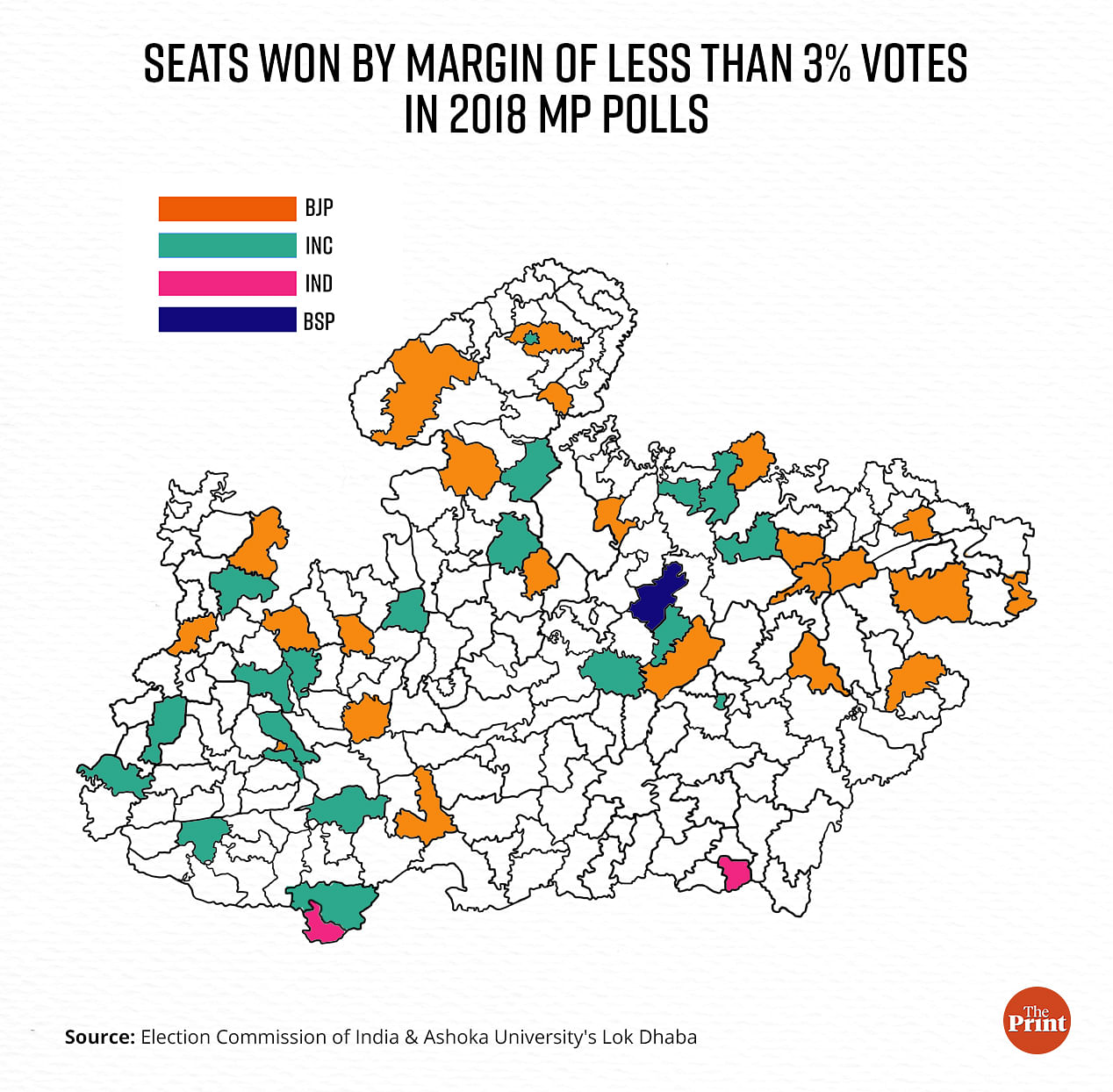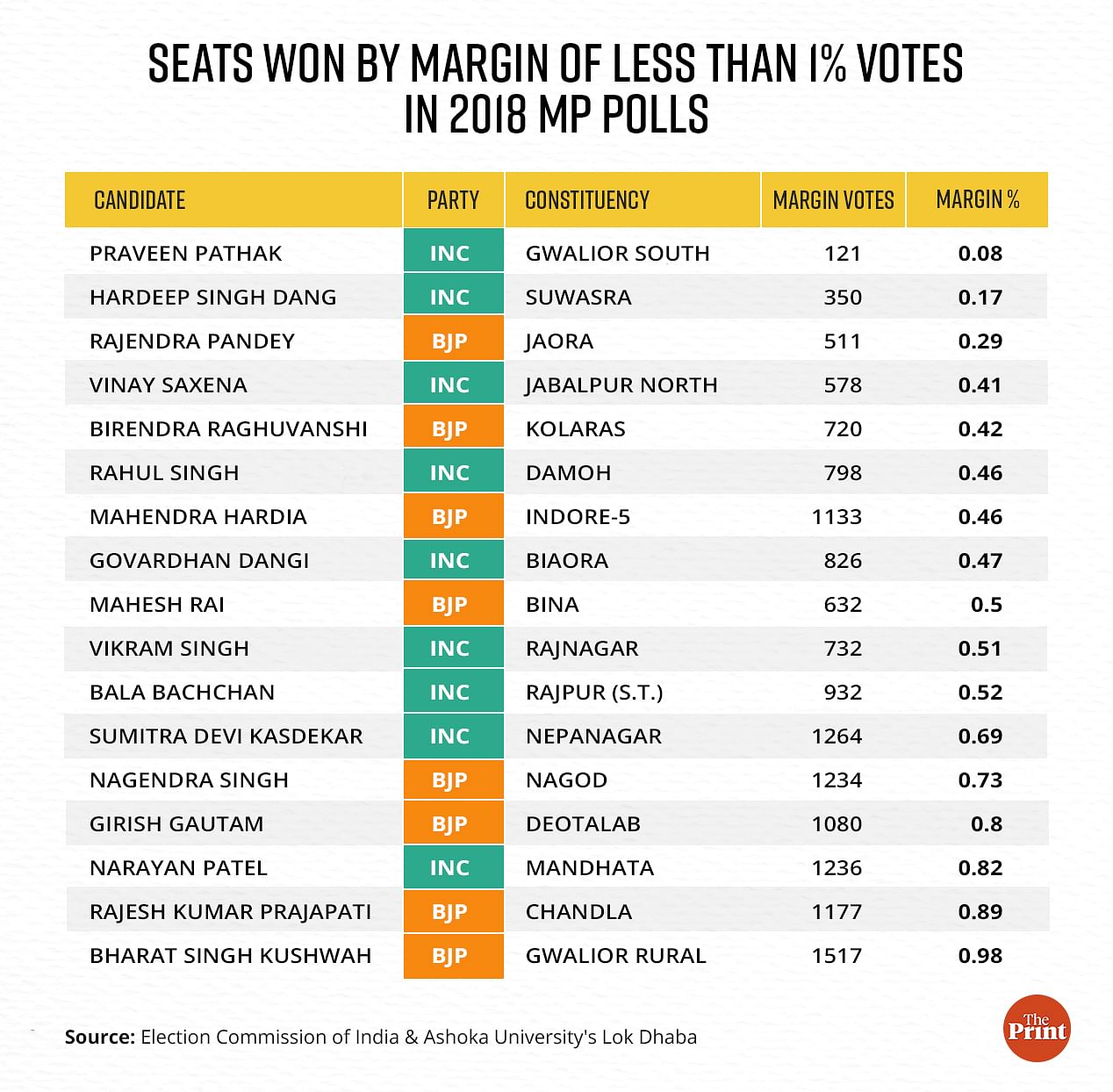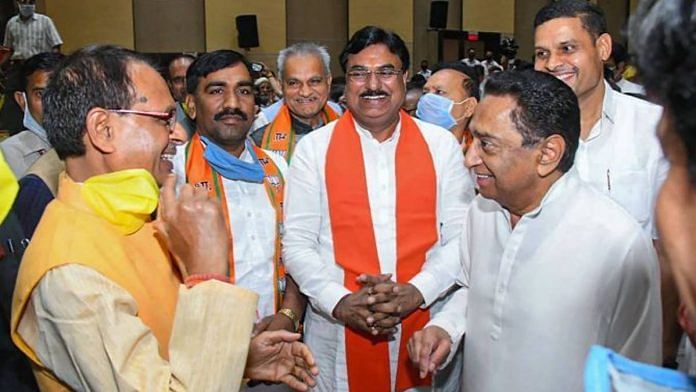New Delhi: A fifth of the 230 assembly seats in Madhya Pradesh were decided by a victory margin of less than three percent in the 2018 elections, an analysis by ThePrint has found, indicating that factional fights in the state’s ruling BJP could affect its prospects in the upcoming polls.
In 2018, the Congress had won 114 seats in Madhya Pradesh, two short of the majority, and proceeded to form a government under Kamal Nath with help from Independents — only to be brought down two years later by a rebellion led by then party leader Jyotiraditya Scindia and 22 MLAs, all of whom joined the BJP.
The BJP had secured 109 seats in the 2018 election and in 2020 formed a government led by Shivraj Singh Chouhan with support from Scindia’s faction.
Out of 46 MLAs who had won by a margin of less than three percent votes in 2018, 23 were from the BJP and 20 from the Congress. Three other seats were won by two Independents and one BSP candidate by wafer-thin margins. The BJP was the runner-up on all three.
The two national parties were engaged in a direct fight on 41 of the 46 seats. On two (Gwalior Rural and Deotalab) of the 23 seats won by the BJP, BSP candidates had stood as runners-up.
Further, of the 46 MLAs who won by close margin, 17 won by less than 1 percent vote share, 13 by 1-2 percent vote share and another 16 by 2-3 per cent vote share, ThePrint analysis found.

BJP and Congress leaders ThePrint spoke to said that special focus was being laid on seats lost by close margins.
Speaking about the seats won by a wafer-thin margin, political analyst and author Rasheed Kidwai told ThePrint: “In Madhya Pradesh, margins have usually been close. Let’s say (candidates who win by) a margin of 2 percent usually decides who’s the winner and loser (at the state level). In fact, in 2018, the BJP was slightly ahead of the Congress in terms of total votes polled.”
He added that the BJP will need a united house in Madhya Pradesh and CM Chouhan for sure “cannot be wished away”.
Also Read: ‘Neglected workers’ & Scindia factor — why BJP is losing leaders to Congress in poll-bound MP
BJP’s divided house
The BJP has had many heavyweights in Madhya Pradesh in the past, such as Uma Bharati and the late Sunder Lal Patwa under whom it got its biggest victories, but it is only under Chouhan that the party has won back-to-back elections.
Chouhan has been the BJP’s face in the state since 2005, when he became CM for the first time and continued in the post till 2018. After a short hiatus, he was back in the saddle in 2020.
He is, however, believed to have fallen out of favour with the BJP high command recently.
While he had led the Jan Ashirwad Yatra in the state in the run-up to the 2018 elections, the BJP didn’t make Chouhan the sole face of the yatra this time, bringing other leaders to the fore as well.
The BJP has also maintained that it will fight this year’s Madhya Pradesh assembly elections under collective leadership, with Prime Minister Narendra Modi as the party’s face in the state.
With the high command not projecting Chouhan as the CM face, at least half-a-dozen other leaders are scrambling to project themselves as the alternative, and the BJP state unit is rife with rivalries.
A divided house could make it tougher for the party on seats that were lost or won by a close margin in 2018.
Speaking about the seats that saw a close contest, BJP’s state vice-president Jitu Jirati told ThePrint that a different strategy had been employed on every seat and the mistakes of 2018 would not be repeated this election.
Referring to the seats BJP lost by a close margin, Jirati said the party had (last month) released its first list of 39 candidates for the seats it had lost, and this showed its focus on these constituencies.
“There is special focus on seats lost by close margin. We have already declared 39 seats four months in advance. Our candidates are already working. We have programme running there,” he explained. “We had lost all these 39 seats. Even if we win 20 of them, it will be a big win.”
On eight of these 39 seats, the BJP had lost by a close margin.
While denying any factionalism in the party, Jirati added that the BJP high command would speak to all those who do not get tickets to avoid any resentment.
“Look at the 39 tickets — it makes it clear that there are no factions. And there are no factions because decisions are taken along with the central leadership,” he said.
‘Problem of surplus candidates’
For the BJP, the fight in 2018 came close even on seats that had been its stronghold for decades.
For instance, the party has lost the seat of Sarangpur only once since 1990 and never lost in Ashta constituency since 1990. But in 2018, both seats saw a close fight with Congress candidates and the BJP managed to win them by a close margin — 2.9 percent or 4,381 votes in Sarangpur and 2.93 percent or 6,044 votes in Ashta.
In another case, BJP’s Rajendra Pandey, who had won the seat of Jaora by a margin of 18.85 percent or 30,000 votes in 2013, managed a victory by just 511 votes or 0.29 percent margin in 2018. His 2013 victory was the biggest for any candidate in over five decades.
Some BJP stalwarts came close to losing their seats in the previous election. For instance, Madhya Pradesh home minister Narottam Mishra, seen as one of the contenders for the CM’s post, secured his seat of Datia by just 2,656 or 1.8 percent of votes.
Ministers Ramkhelawan Patel (Amarpatan) and Bharat Singh Kushwah (Gwalior Rural) won their seats by 3,747 votes (2.24 percent victory margin) and 1,517 votes (0.98 percent victory margin), respectively.
Further, BJP heavyweight Sharad Jain was defeated by the Congress’ Vinay Saxena from Jabalpur North by just 578 votes (0.41 percent) in 2018. Jain had won the seat twice previously by a victory margin of more than 50 percent.

According to political analyst Kidwai, the BJP faces the problem of surplus candidates, especially because it has gained members from other parties.
“The problem (of small margin seats) is where rebels, Independents and smaller parties come into play. Therefore, the BJP has more disquiet than the Congress. In about 40+ constituencies, the BJP has surplus contenders,” he explained.
“Even if political management and all those things work, there is a fair scope that one person will be disgruntled. This is where the BJP has more ground to cover than the Congress,” he said, adding that “the Congress campaign, because of Scindia’s exit, has become far more streamlined”.
Congress banks on anti-incumbency
The Congress saw close victories on 20 seats in Madhya Pradesh in 2018.
Among these were that of Praveen Pathak, a first-time MLA, who defeated former BJP minister Narayan Singh Kushwah in Gwalior South by mere 121 or (0.08 percent) votes.
Hardeep Singh Dang, now a minister in the Chouhan government, won the seat of Suwasra by a margin of 350 (or 0.17 percent) votes. Another Congress stalwart and Pichhore MLA since 1993, K.P. Singh, for the first time won his seat by less than 5,000 votes in 2018.
Of the 22 Congress legislators who switched sides to the BJP in 2020, half-a-dozen had won their seats by a close margin in the previous election.
In the bypolls following their defection, for five of the six candidates, their margin of victory only increased. One Rahul Singh — who had won from Damoh by a margin of 800 votes in 2018 — lost his seat to Congress candidate Ajay Kumar Tandon in the 2021 bypoll.
Congress’ chief spokesperson in Madhya Pradesh, K.K. Mishra, speaking about the importance of close-margin seats during government formation, told ThePrint: “(Our) government was brought down by the BJP using black money. They bought Scindia. Our focus is definitely on seats that we lost by a close margin. And then we have a separate strategy for seats that we have lost continuously or where we are weak.”
Mishra believes that on seats the party won by a close margin, anti-incumbency against the Chouhan government will help widen its victory margin.
“Full efforts are being made to win these seats by bigger margins. A lot will be covered by anti-incumbency alone,” he said. “This time we are going to form a government with two-thirds majority under the leadership of Kamal Nathji.”
(Edited by Nida Fatima Siddiqui)
Also Read: Inside story of how Rahul Gandhi, Sonia Gandhi forced Jyotiraditya Scindia to dump Congress



